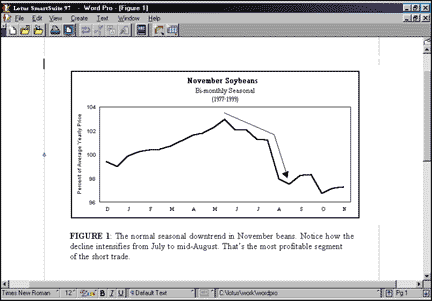REAL WORLD
Seasonal Trades And The Channel Breakout System
by John L. Momsen
Many seasonal trades have been consistently profitable over many years, but using them can be tricky because you never know if this will be the year that events won't follow the established patterns. You can gauge whether patterns are breaking as expected by using the channel breakout system.
Seasonal trades often come with 90% success rates, but that's historical information. You need to know what's happening now as you put on a trade. Nothing's more frustrating than entering -- and exiting -- at the historical right time, only to take a loss. Here, then, is a technique for a seasonal trade confirming your entry point using the channel breakout system, versions of which are widespread in trading. Using channel breakout, you can bump up your personal success rate on seasonals to over the 90% mark.

FIGURE 1: NOVEMBER SOYBEANS, BIMONTHLY SEASONAL (1977-99). Seen here are two very distinct price trends. The first, an uptrend, begins in mid-December and is driven by the normal decline in available oil seed supplies. The second, and far more extensive, is the downtrend that begins after the uptrend tops out in the middle of May.
As an experienced futures trader, I am a confirmed believer in the power and profitability of seasonal trading. For the uninitiated, seasonals are defined as the up and down market trends or yearly cycles that recur at approximately the same time each year. A seasonal trader normally adheres to a calendar of entry and exit dates as the bases for making trading decisions.
MEGASEASONALS
True megaseasonal trades are those driven by powerful, fundamental pressures -- weather conditions during planting, growing, and harvesting, in the case of grains or oil seeds (soybeans). In the case of equity indices, it's the close of the fiscal year, the expectations and results of the Christmas shopping season, and the computation of the year-end performance bonus checks for the thousands of mutual fund managers. In addition, you can't forget about the normally close relationship between the direction of interest rate futures and the flow of income tax moneys into the federal government's coffers.
To get specific, the November soybean short sale is one of the strongest and most consistently reliable of the 41 seasonal trades I follow each year. It profits from the rapid price decline in November soybeans (the new crop) from the planting season to harvest. The farther soybeans progress into the growing season, the more is known about the eventual size and condition of the crop. As traders and hedgers become more and more certain that a good crop is about to be harvested, additional farmers begin their hedging operations, private traders short the contract, and end-users close their long price-protecting positions. These sales drive the price downward.
John Momsen, 909 466-4053, has been an active private trader for the last 25 years.
Excerpted from an article originally published in the February 2000 issue of Technical Analysis of STOCKS & COMMODITIES magazine. All rights reserved. © Copyright 2000, Technical Analysis, Inc.
Return to February 2000 Contents